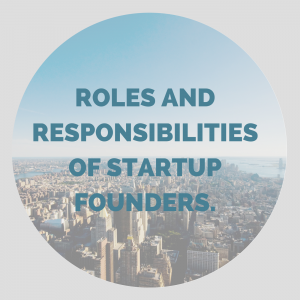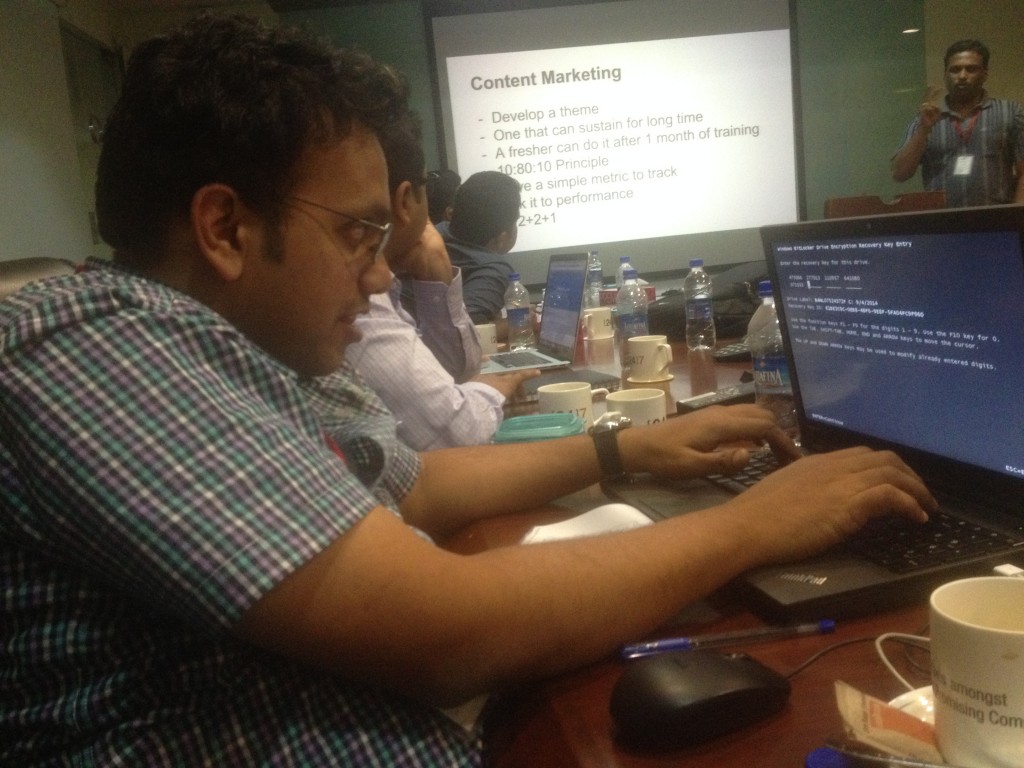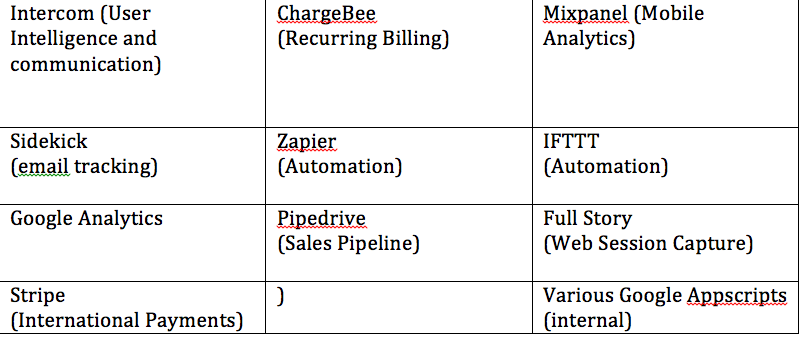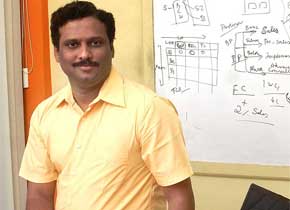Pune… the city of life. It’s a place you can easily fall in love with. Fun loving yet grounded folks who talk sense. Light drizzle, clean roads and a young city full of aspiring students who want to change the world. So when Product Nation announced it Playtable in Pune I latched on to the opportunity. Avinash and his iSPIRT team have been doing some wonderful work over the years in leading the way for SaaS startups. The topic itself was close to my heart ” Nuts and bolts of selling to US market for B2B SaaS companies” and when you have the ‘Google of B2B SaaS marketing’ Suresh Sambandam conducting it, you don’t want to let it go. Google coz if you have a query he has the right answer. Over the years Suresh has done some real hardwork in taking Kissflow to 10000+ customers and he has fixed all those nuances of SaaS selling by getting into depth of it.
 So on a pleasant Saturday morning , 30th May to be precise, we a bunch of 15 entrepreneurs and few aspiring ones gathered to know how to make it BIG by earning in dollars. United States is by far the biggest market for SaaS companies and if you get it right there you will make it BIG one day.
So on a pleasant Saturday morning , 30th May to be precise, we a bunch of 15 entrepreneurs and few aspiring ones gathered to know how to make it BIG by earning in dollars. United States is by far the biggest market for SaaS companies and if you get it right there you will make it BIG one day.
We started with basic introductions and brief product details. It’s really heartening to see how enterprising the current generation is. We guys today are proud to be entrepreneurs or employees of startups. It shows you can take risks, think outside the box and are not satisfied with status quo. I can surely see that the next gen of aspiring entrepreneurs will come from those who work with startups. And why not. If you can make a startup successful, you surely can build one for yourself.
Our workshop focused on B2B SaaS startups. How can you sell your B2B product to US customers sitting out of India? Yes, selling to them without even meeting them.
B2B selling has traditionally been about relationships, face to face meetings, getting to know your customers, value selling and all. But, cloud computing has totally disrupted the market. In fact it has expanded the IT market globally. Today millions of SMB and mid market clients can afford to automate their marketing, sales, operations etc using cloud solutions on SaaS model. And if your product can add value to their business they care a damn as to where you are based. I think we should thank the first generation B2B SaaS Startups like Zoho, Freshdesk, Kissflow, Druva etc who have built the trust and confidence in US customers that world class solutions can be delivered from India. We the 2nd generation now need to ensure that put our best foot forward in terms of quality of product and support when we reach out to them.
The views I’m sharing are a glimpse of insights given by Suresh and interactions during the round table . In between you’ll see important tips from suresh which I’m calling it KiSSTiP 🙂
To understand the process best we looked at it in a logical flow.
- The Product
- Market fitment
- Pricing
- Marketing
- Sales
- Customer success
The Product first – In SaaS marketing you need to have a good working product. Unlike face to face selling where you can do with ppt selling and bit of account mapping, SaaS needs the working product first. In fact you can use your product as a marketing tool building in features to engage, upsell and cross sell. The important point is how do you position your product amongst three below :
- Category Creator
- Novel Approach to an existing well understood category
- Low cost alternative
 The group agreed that a combination of 2 and 3 would be ideal to reach the right set of customers. Being a category creator – someone who creates a new market needs a lot of investment and F2F interaction. But low cost should not be confused with cheap. We need to build solutions with world class quality at minimal cost thereby passing the benefits to the customers. That creates high value product for them.
The group agreed that a combination of 2 and 3 would be ideal to reach the right set of customers. Being a category creator – someone who creates a new market needs a lot of investment and F2F interaction. But low cost should not be confused with cheap. We need to build solutions with world class quality at minimal cost thereby passing the benefits to the customers. That creates high value product for them.
Next comes the market definition. Suresh shared the segmentation based on number of employees into SOHO(1-10), VSMB(10-50),SMB(50-500),mid market (500-5000) and enterprise (5000+). The sweet spot for SaaS marketing lies in the SMB and mid market space. In terms of who decides on buying your product, in SMB whosoever may be evaluating, the founder or owner will somewhere get involved before the purchase. As we move towards mid market and then enterprise customers, the line of business (LOB) guys have a larger influence apart from IT team who might get involved. Also which geography to target and what languages to support. US and English are big enough to start and one should look at other countries probably in growth phase.
KiSSTiP !
SaaS startups should focus on ONE Country, ONE language first to ensure they remain focused.
Now that you know what your product market fit, how do you reach out to the US clients and get them to buy your product ? The process of customer acquisition was simplified by Suresh in four steps
- Marketing
- Product engagement
- Sales
- Customer success
While the nitty gritty may vary by the type of solution, the role of marketing is to get people to sign up for a trial or free account. Unlike B2C , in B2B the customer has to see the product demo. This is where the product team steps in to ensure the solution and get the customer engaged and use your product during trial period. If the customer is not using your product during trial, he probably won’t buy it. Once the product team ensures a good product experience, the sales team steps in to ensure conversion. Sales team can dived into ‘hunters’ – ones who get the customers and ‘farmers’ ones who nurture the relationship to upsell and cross sell. The customer success team ensures that the customers realise value from your solution. The metrics and handover points for each team needs to be meticulously set and communicated.
KiSSTiP !
The support queries from customers during early days of engagement should come to sales team and not support team as it is an opportunity for you to grow the relationship. But seller should get the issue fixed first and then engage further.
 We discussed the marketing process in detail including SEO and Adwords, social media, content marketing, blogging. The importance of google and the traffic it generates is immense so SEO and Adwords are an important piece but the two need different specialised roles. The role of marketing is to get enough leads digitally. These can be through organic search- Google, Yahoo, Bing etc). While google still dominates the majority of the US market, those targeting elderly citizens might want to reach out via Bing as they still have a lot of elderly crowd there. SEO requires identifying your keywords as per the target geography and product. It needs meticulous tracking of keyword ranking every 2 weeks. Fact is if you are not on FIRST page of google, its not worth.
We discussed the marketing process in detail including SEO and Adwords, social media, content marketing, blogging. The importance of google and the traffic it generates is immense so SEO and Adwords are an important piece but the two need different specialised roles. The role of marketing is to get enough leads digitally. These can be through organic search- Google, Yahoo, Bing etc). While google still dominates the majority of the US market, those targeting elderly citizens might want to reach out via Bing as they still have a lot of elderly crowd there. SEO requires identifying your keywords as per the target geography and product. It needs meticulous tracking of keyword ranking every 2 weeks. Fact is if you are not on FIRST page of google, its not worth.
Till you get enough of organic crowd in, AdWords can fill in. Adwords is all about number crunching and reaching to an optimum cost per lead. Ashish and his Sokrati team shared their insights on managing adwords as that’s their area of specialisation and promised to conduct a detailed session later some time. Suresh shared insights into digital ROI metrics for AdWords. On an average you can get a signup for $10-$25 for search ads and $2-$10 for display ads. However the conversion seems better for search ads as these are real customers searching for specific requirements whereas in display ads are shown on sites which might have these customers as one of their target audience.
We discussed social media marketing – LinkedIn and Twitter and content marketing (blogging, case study creation etc) in detail. The group shared its experiences on getting leads from Quora and forum discussions. The internet now days is getting really crowded so you need to figure out which group is giving you the returns rather than spraying your messages across all over. Content marketing can be a differentiator in this crowded digital world- the quality not the quantity matters there. Suresh shared how his team publish two customer experience blogs every week where they share live feedbacks from actual customers. Retargeting helps you bring the same vistors back to your site and improve the ROI on your existing marketing spends. While content creation is important, content publishing is as much an important task. We discussed tools like Outbrain and Taboola for content distribution. Talking of tools, the groups discussed a host of SaaS tools that can be used by startups to more efficient like Pipedrive, ChargeBee, Intercom, Mixpanel, Google Analytics etc.
KiSSTiP !
Suresh shared his 10-80-10 principle for creating quality content. If total expected time for writing a piece of content is 100, spend 10 on briefing the content writer in the beginning, let them write for next 80- spend 10 on final review. The fact is the best content writers wont be able to understand your solution and market to the extent you do. So a 10 % briefing time can save them a lot effort and set them in the right direction.
We discussed the important aspect of pricing which also brought us to the discussion on Freemium Vs Free Trial. Majority of the group went in favour of Free trial over Freemium as they felt that the customers didn’t see value in fremium. While there is no thumb rule for this, solutions where SaaS products can get self signup can still look at Freemium to upgrade them later. On pricing, different team members shared their views on their basis of pricing. Some did it bottoms up on cost plus model where as others looked at the competitive pricing.
Pricing is an important aspect so ensure you keep taking feedback from your early customers and incorporate that feedback.
Finally, the most important aspect of execution is measuring the key metrics. As your team grows you need to push a dashboard of metrics which alert you on any activites that are going offtrack or to scale up things. Conversion Ratio, Conversion through Paid vs Organic, Organic Traffic by Source, Signup Trend Paid vs Organic vs Source,Paid traffic by Source, CPS for Paid and Overall, A-ARPA trend 12 months, etc are some of the important metrics.
All in all, I must say, it was one the most informative and engaging workshops I ever attended. It was a crash of 2 years of learning compiled into a 8 hour workshop. What if we were to pay for this workshop ? How much would we be willing to pay? Marketing strategy workshop $300, Leadership training $1000
Product Nation RT on Selling SaaS product to US – Priceless !
Kudos to Avinash for oranising, Sokrati team for being a great host and Suresh for conducting the round table. At 49 not out, half century is round the corner for Product Nation round tables and I’m sure in for a long innings. As long as they bat with us, we are sure to win in the end !


 So on a pleasant Saturday morning , 30th May to be precise, we a bunch of 15 entrepreneurs and few aspiring ones gathered to know how to make it BIG by earning in dollars. United States is by far the biggest market for SaaS companies and if you get it right there you will make it BIG one day.
So on a pleasant Saturday morning , 30th May to be precise, we a bunch of 15 entrepreneurs and few aspiring ones gathered to know how to make it BIG by earning in dollars. United States is by far the biggest market for SaaS companies and if you get it right there you will make it BIG one day. The group agreed that a combination of 2 and 3 would be ideal to reach the right set of customers. Being a category creator – someone who creates a new market needs a lot of investment and F2F interaction. But low cost should not be confused with cheap. We need to build solutions with world class quality at minimal cost thereby passing the benefits to the customers. That creates high value product for them.
The group agreed that a combination of 2 and 3 would be ideal to reach the right set of customers. Being a category creator – someone who creates a new market needs a lot of investment and F2F interaction. But low cost should not be confused with cheap. We need to build solutions with world class quality at minimal cost thereby passing the benefits to the customers. That creates high value product for them. We discussed the marketing process in detail including SEO and Adwords, social media, content marketing, blogging. The importance of google and the traffic it generates is immense so SEO and Adwords are an important piece but the two need different specialised roles. The role of marketing is to get enough leads digitally. These can be through organic search- Google, Yahoo, Bing etc). While google still dominates the majority of the US market, those targeting elderly citizens might want to reach out via Bing as they still have a lot of elderly crowd there. SEO requires identifying your keywords as per the target geography and product. It needs meticulous tracking of keyword ranking every 2 weeks. Fact is if you are not on FIRST page of google, its not worth.
We discussed the marketing process in detail including SEO and Adwords, social media, content marketing, blogging. The importance of google and the traffic it generates is immense so SEO and Adwords are an important piece but the two need different specialised roles. The role of marketing is to get enough leads digitally. These can be through organic search- Google, Yahoo, Bing etc). While google still dominates the majority of the US market, those targeting elderly citizens might want to reach out via Bing as they still have a lot of elderly crowd there. SEO requires identifying your keywords as per the target geography and product. It needs meticulous tracking of keyword ranking every 2 weeks. Fact is if you are not on FIRST page of google, its not worth.
 Product Market Fit
Product Market Fit SEO
SEO
 Tools
Tools







